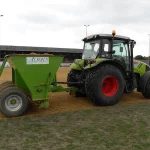Are you trying to choose the right flooring for your chicken run? It’s such an important part of keeping your feathered friends healthy, clean, and comfortable that often gets over-looked! The surface that your flock roams around on affects everything from hygiene and drainage to the smell and how easy it is to keep the run clean. Muddy, compacted or unhygienic ground can very quickly result in health problems like foot issues or parasites, therefore, must be taken very seriously!
Here at Alsoils our goal is to help our customers across the South with trusted, poultry-safe materials for all their gardening needs. With over 35 years of experience supplying topsoil, bark, compost and gravel, we know what works well in real-life situations. This guide will help you decide what options you have for your chicken run and which flooring will suit your needs best.
Why Flooring Matters in a Chicken Run
Flooring in a chicken run plays such a huge role in your birds’ overall health and wellbeing. It can affect how easy it is to maintain the run, how clean it stays and how safe it is for your chickens to walk, rest and scratch.
Shoddy ground conditions will often result in a build-up of bacteria, moisture, and parasites. This can then drastically increase the chance of your chickens developing foot issues, bad smells or even diseases! A good surface will help to reduce mess, improve drainage, and make your life cleaning out the run that much easier!
Picking the best flooring for you means considering many factors like the weather, the size of your chicken run, and how frequently it will be cleaned and topped up. The right setup will keep your run dry, safe and comfortable for your hens all year round.
6 Things to Consider Before Choosing Your Flooring
When deciding on flooring for your chicken run, it is key to think about how the space will be used and what will be best for the routine of your birds. Here are the main points to consider:
- Drainage
Effective drainage is very important when it comes to avoiding muddy conditions. There are certain materials that hold moisture and others that will help the water drain away more easily, resulting in a dryer run.
- Cleaning and maintenance
Consider how easy a surface is to clean, replace or rake. You want a run flooring that is easy to maintain as this will save you far more time and effort in the long run.
- Hygiene
Having the right ground cover can reduce the chance of parasites, bad smells, and bacteria. There are materials that are more hygienic than others, particularly when used with a high-quality base layer.
- Comfort and safety
It is always best to stay clear of sharp or overly compacted materials. It’s recommended that chickens should live on surfaces that are soft and natural to avoid hurting their feet.
- Cost and availability
Options like bark or woodchip are affordable and easily available. Other materials can cost more but are more likely to last longer and need less frequent maintenance.
- Type of run
Whether you have a covered or uncovered run can mean different materials are better. A protected, sheltered run will stay drier, whereas open areas will require far better drainage and more upkeep.
Every chicken owner will have a different setup, but if you consider these factors you can add a flooring solution to your run that works better for you and even better for your flock!
Popular Chicken Run Flooring Options: Pros and Cons
There are so many options when it comes to chicken runs. Each option comes with its benefits and drawbacks. A lot of keepers will choose to layer or combine their materials to achieve the best results for drainage, hygiene, and flock comfort.
Bark chippings or woodchip
Pro: Bark chippings and woodchip offer a gentle surface that is great for chickens’ feet and help to soak up moisture and is nice and easy to rake over. If you have a run that is pretty well drained and ventilated, bark could be a good option for everyday use.
Con: However, it is important to note that they will break down over time and could need replacing every few months.
Sand
Pro: Sand is a very favoured material, particularly for covered chicken runs. Sand offers great drainage and encourages natural dust bathing.
Con: Unfortunately, sand can become very compacted and dusty over time. Sand can also become very hot in summer and much colder in winter, which could both lead to discomfort for your birds!
Gravel
Pro: It works very well as a base layer beneath softer materials, like woodchip. It will help to improve drainage, reduce mud and has good durability.
Con: Gravel isn’t usually used on its own for a chicken run,it can be harsh if used alone and should always be topped with something that will add comfort for your birds under foot.
Topsoil or compost
Pro: Topsoil or compost is great for encouraging natural scratching and foraging, which is great if you have a free-range or rotating run. Due to its soft nature it allows chickens to dig and explore it.
Con: Its downside is that it can very quickly turn to mud in wet weather and will need refreshing more regularly to stay hygienic.
Agricultural lime
Bonus: Although agricultural lime isn’t a flooring material, it can be great for improving hygiene in chicken runs. Just sprinkle and rank into the surface and it will help to neutrilise bacteria, reduce smells and prevent the chances of parasite build up. It is important that you use the correct type, called hydrated lime, not builders’ lime, and follow the instructions provided. Lime works very well as a treatment in-between flooring changes or to maintain cleanliness in damper conditions.
If you understand the pros and cons of each option, it will help you to build a surface for your chickens that suits their needs as well as your maintenance preferences.
What Flooring Does Alsoils Recommend?
Our team at Alsoils regularly help customers pick the right materials for their chicken runs depending on their conditions. Often we will recommend a layered approach for the best hygiene, drainage and comfort for your feathered friends.
If you have a smaller garden run, we would recommend a gravel base that is topped with woodchip or bark. Gravel will prevent mud building up and bark wil give a soft, easy to maintain finish that your chickens will love scratching in!
For runs that are covered we advise you use sand. This is a really practical option that drains well, is easy to clean and allows for dust bathing. Just note it could need topping up over time.
If your chickens have a larger or a rotating run, topsoil or compost will give a really natural feel for your chickens that encourages foraging. Just keep in mind this type of surface will get muddy in wet weather so maintenance is important here.
If you still feel unsure about the best option for your layout and conditions, please just speak to one of our expert team! They will be more than happy to help you and your chickens find the right surface.
View Our Products Get in Touch
How to Maintain Chicken Run Flooring Year-Round
To keep your run clean, dry and safe for your birds, maintenance is so important. Frequent care can help to reduce mess, control odour and help keep health issues at bay over the year. Follow these three steps to keep your run looking its best:
- Begin by raking the surface frequently, this will remove any droppings and loose material. It will also help prevent a build-up of bacteria, meaning the area will stay fresher for longer. Depending on your chosen material you could need to replace your flooring every couple of months. Materials like compost and bark naturally break down over time.
- During rainy weather it is important to monitor your run for areas that could hold water or become compacted. If this does occur, you should consider improving the base layer with gravel or refreshing your surface to help improve drainage.
- Improving your runs hygiene is always beneficial. Using agricultural lime in-between flooring changes will help to control bacteria and reduce bad odour, especially during colder months or periods with heavy rainfall.
Overview
Using the correct flooring for your circumstances can make such a difference in the health and wellbeing of your chickens! From managing mud and mess to keeping the run as clean and comfortable as possible, the material you pick should always suit your space and routine. Each option has its benefits and setbacks, but it’s up to you to know how your run is used and what will improve the space.
At Alsoils, we take pride in supplying such a wide range of poultry-safe materials that will help you build the best environment for your flock. If you still feel unsure about what is best for your run, our expert team will happily offer advice and recommend the right products for your needs, just give us a call today.





